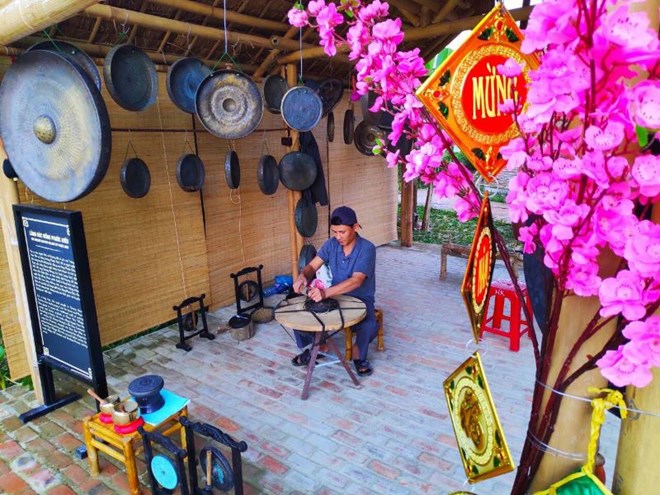
Craft villages are at the centre of a series of lunar New Year (Tet) activities, which are taking place at the Hoi An Impression Theme Park in Hoi An city, a World Heritage site in the central province of Quang Nam, from January 11 to February 11.

A site at the theme park (Photo: kinhtedothi.vn)
The spaces of five Quang Nam’s traditional craft villages – Phuoc
Kieu specialising in bronze-casting , Kim Bong in wood-making, Thanh Nam in
fishing, Hoi An in lantern-making, and Thanh Ha in pottery making – are created
at the park.
Visiting the park on the occasion, tourists can play archery games, join boat
races, try casting bronze, make conical hats and pottery, and design their own
lanterns. They are also treated to Bai Choi singing performances, folk games,
street food, and a Chung cake festival that offers hands-on experiences.
At 5pm everyday, a dancing show, titled ‘Hoi An world’, is scheduled to
re-enact the Hoi An port of the old days.
Meanwhile, the colourful musical show named Hoi An Memories takes place between
7.30 and 8.40 pm. Featuring a cast of nearly 500 actors and actresses on a
25,000 sq. m stage across the Hoai river, it recalls the memories of Hoi An as
a prosperous trading port over 400 years.
The 10-hectare theme park includes indoor and outdoor theatres, shopping and
entertainment complexes.
Source: VNA
With an increasingly vibrant and widespread emulation movement aimed at building cultured residential areas and cultured families, Yen Thuy District has been making steady progress toward improving both the material and spiritual well-being of its people, while fostering a civilized, prosperous, beautiful, and progressive community.
Once lacking recreational spaces and community facilities, Residential Group 2 in Quynh Lam Ward (Hoa Binh City) has recently received attention for the construction of a new, spacious, and fully equipped cultural house. The project followed the model of state support combined with public contributions in both labor and funding.
The "All people unite to build cultural life" movement, which has been effectively integrated with Kim Boi district’s socio-economic development goals, is fostering a lively spirit of emulation across local residential areas, hamlets, villages, public agencies, and enterprises. In addition, through the initiative, traditional cultural values are being preserved and promoted, while community solidarity and mutual support in poverty reduction and economic development are being strengthened.
A working delegation of the Hoa Binh provincial People’s Committee led by its Permanent Vice Chairman Nguyen Van Toan on June 11 inspected the progress of a project to build the Mo Muong Cultural Heritage Conservation Space linked to tourism services in Hop Phong commune, Cao Phong district.
Born and growing in the heroic land of Muong Dong, Dinh Thi Kieu Dung, a resident in Bo town of Kim Boi district, in her childhood was nurtured by the sweet lullabies of her grandmother and mother. These melodies deeply imprinted on her soul, becoming an inseparable part of her love for her ethnic group's culture. For over 20 years, this love for her hometown has driven Dung to research, collect, and pass down the cultural values of the Muong people to future generations.
In the final days of May, the Ethnic Art Troupe of Hoa Binh Province organized performances to serve the people in remote, mountainous, and particularly disadvantaged areas within the province. These were not just ordinary artistic shows, but they were the meaningful journeys aimed at spreading cultural values, enhancing the spiritual life of the people and contributing to the preservation of ethnic minority cultural identities.



